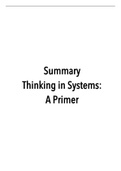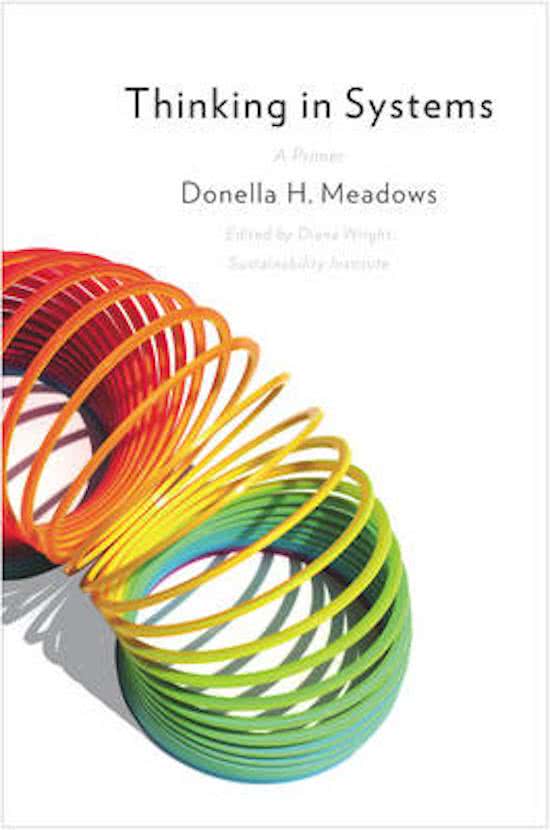Summary
Thinking in Systems:
A Primer
, Part One | Systems Structure and Behaviour
Chapter 1 – The Basics
More than the Sum of Its Parts
A system is an interconnected set of elements that is coherently organized in a way that achieves something. A system
must consist of three kinds of things: elements, interconnections, and a function or purpose. Systems can be embedded
in systems, which are embedded in yet other systems. Is there anything that is not a system? Yes – a conglomeration
without any particular interconnections or function. A system is more than the sum of its parts. It may exhibit adaptive,
dynamic, goal-seeking, self-preserving, and sometimes evolutionary behaviour. There is an integrity or wholeness about
a system and an active set of mechanisms to maintain that integrity. Systems can change, adapt, respond to events, seek
goals, mend injuries, and attend to their own survival in lifelike ways, although they may contain or consist of non-living
things. Systems can be self-organizing, and often are self-repairing over at least some range of disruptions. They are
resilient, and many of them are evolutionary. Out of one system other completely new, never-before-imagined systems
can arise.
Look Beyond the Players to the Rules of the Game
The elements of a system are often the easiest parts to notice, because many of them are visible, tangible things.
Elements do not have to be physical things. Intangibles are also elements of a system. You can divide elements into sub-
elements and then sub-sub-elements. Before going too far in that direction, it’s a good idea to stop dissecting out
elements and to start looking for the interconnections, the relationships that hold the elements together. It’s easier to
learn about a system’s elements than about its interconnections. Some interconnections in systems are actual physical
flows (e.g., students progressing through an uni). Many interconnections are flows of information – signals that go to
decision points or action points within a system. These kinds of interconnections are often harder to see, but the system
reveals them to those who look. If information-based relationships are hard to see, functions or purposes are even harder.
A system’s function or purpose is not necessarily spoken, written, or expressed explicitly, except through the operation of
the system. The best way to deduce the system’s purpose is to watch for a while to see how the system behaves. Purposes
are deduced from behaviour, not from rhetoric or stated goals.
The word function is generally used for a nonhuman system, the word purpose for a human one, but the distinction is not
absolute, since so many systems have both human and nonhuman elements. An important function of almost every
system is to ensure its own perpetuation. System purposes need not to be human purposes and are not necessarily those
intended by any single actor within the system. In fact, one of the most frustrating aspects of systems is that the purposes
of subunits may add up to an overall behaviour that no one wants. Systems can be nested within systems. Therefore,
there can be purposes within purposes. Keeping sub-purposes and overall systems purposes in harmony is an essential
function of successful systems. You can understand the relative importance of a system’s elements, interconnections, and
purposes by imagining them changed one by one. Changing elements usually has the least effect on the system.
A system generally goes on being itself, changing only slowly if at all, even with complete substitutions of its elements –
as long as its interconnections and purposes remain intact. If the interconnections change, the system may be greatly
altered. Changing interconnections in a system can change it dramatically. Changes in function or purpose also can be
drastic. A change in purposes changes a system profoundly, even if every element and interconnection remains the
same. To ask whether elements, interconnections, or purposes are most important in a system is to ask an unsystematic
question. All are essential. All interact. All have their roles. But the least obvious part of the system, its function or
purpose, is often the most crucial determinant of the system’s behaviour. Interconnections are also critically important.
Changing relationships usually changes system behaviour. The elements, the parts of systems we are most likely to
notice, are often (not always) least important in defining the unique characteristics of the system – unless changing an
element also results in changing relationships or purpose.
, A stock is the foundation of any system. Stocks are elements of the
system that you can see, feel, count, or measure at any given time. A
stock does not have to be physical. Stocks change over time through the
actions of a flow. Flows are filling and draining, births and deaths, purchases and sales, growth and decay, deposits and
withdrawals, successes, and failures. A stock, then, is the present memory of the history of changing flows within the
system. All system diagrams, models and descriptions are simplifications of the real world.
When something is in a state of dynamic equilibrium, its level does not change, although e.g., water is continuously
flowing through it.
- As long as the sum of all inflows exceeds the sum of all outflows, the level of the stock will rise.
- As long as the sum of all outflows exceeds the sum of all inflows, the level of the stock will fall.
- If the sum of all outflows equals the sum of all inflows, the stock level will not change; it will be held in dynamic
equilibrium at whatever level it happened to be when the two sets of flows became equal.
You can adjust the flows abruptly, but it is much more difficult to change the level of the stock. A stock takes time to
change, because flows take time to flow. That’s a vital point, a key to understanding why systems behave as they do.
Stocks usually change slowly. They can act as delays, lags, buffers, ballast, and sources of momentum in a system. Stocks,
especially large ones, respond to change, even sudden change, only by gradual filling or emptying. Changes in stocks set
the pace of the dynamics of systems. The time lags that come from slowly changing stocks can cause problems in
systems, but they also can be sources of stability. The time lags imposed by stocks allow room to maneuver, to
experiment, and to revise policies that aren’t working. You can use the opportunities presented by a system’s momentum
to guide it toward a good outcome. There is one more important principle about the role of stocks in systems, a principle
that will lead us directly to the concept of feedback. The presence of stocks allows in- and outflows to be independent of
each other and temporarily out of balance with each other. Most individual and institutional decisions are designed to
regulate the levels in stocks. People monitor stocks constantly and make decisions and take actions designed to raise or
lower stocks or to keep them within acceptable ranges. Those decisions add up to the ebbs and flows, successes and
problems, of all sorts of systems. Systems thinkers see the world as a collection of stocks along with the mechanisms for
regulating the levels in the stocks by manipulating flows. That means system thinkers see the world as a collection of
‘’feedback processes’’.
How the System Runs Itself – Feedback
When a stock grows by leaps and bounds or declines swiftly or is held within a certain range no matter what else is going
on around it, it is likely that there is a control mechanism at work. In other words, if you see a behaviour that persists over
time, there is likely a mechanism creating that consistent behaviour. That mechanism operates through a feedback loop.
It is the consistent behaviour pattern over a long period of time that is the first hint of the existence of a feedback loop. A
feedback loop is formed when changes in a stock affect the flows into or out of that same stock. A feedback loop can be
quite simple and direct. Feedback loops can cause stocks to maintain their level within a range or grow or decline. In any
case, the flows into or out of the stock are adjusted because of changes in the size of the stock itself. Whoever or whatever
is monitoring the stock’s level begins a corrective process, adjusting rates of in- or outflow (or both) and so changing the
stock’s level. The stock level feeds back through a chain of signals and actions to control itself.
Not all systems have feedback loops. Some systems are relatively simple open-ended chains of stocks and flows. The
chain may be affected by outside factors, but the levels of the chain’s stocks don’t affect its flows. A feedback loop is a
closed chain of causal connections from a stock, through a set of decisions or rules or physical laws or actions that are
dependent on the level of the stock, and back again through a flow to change the stock.






